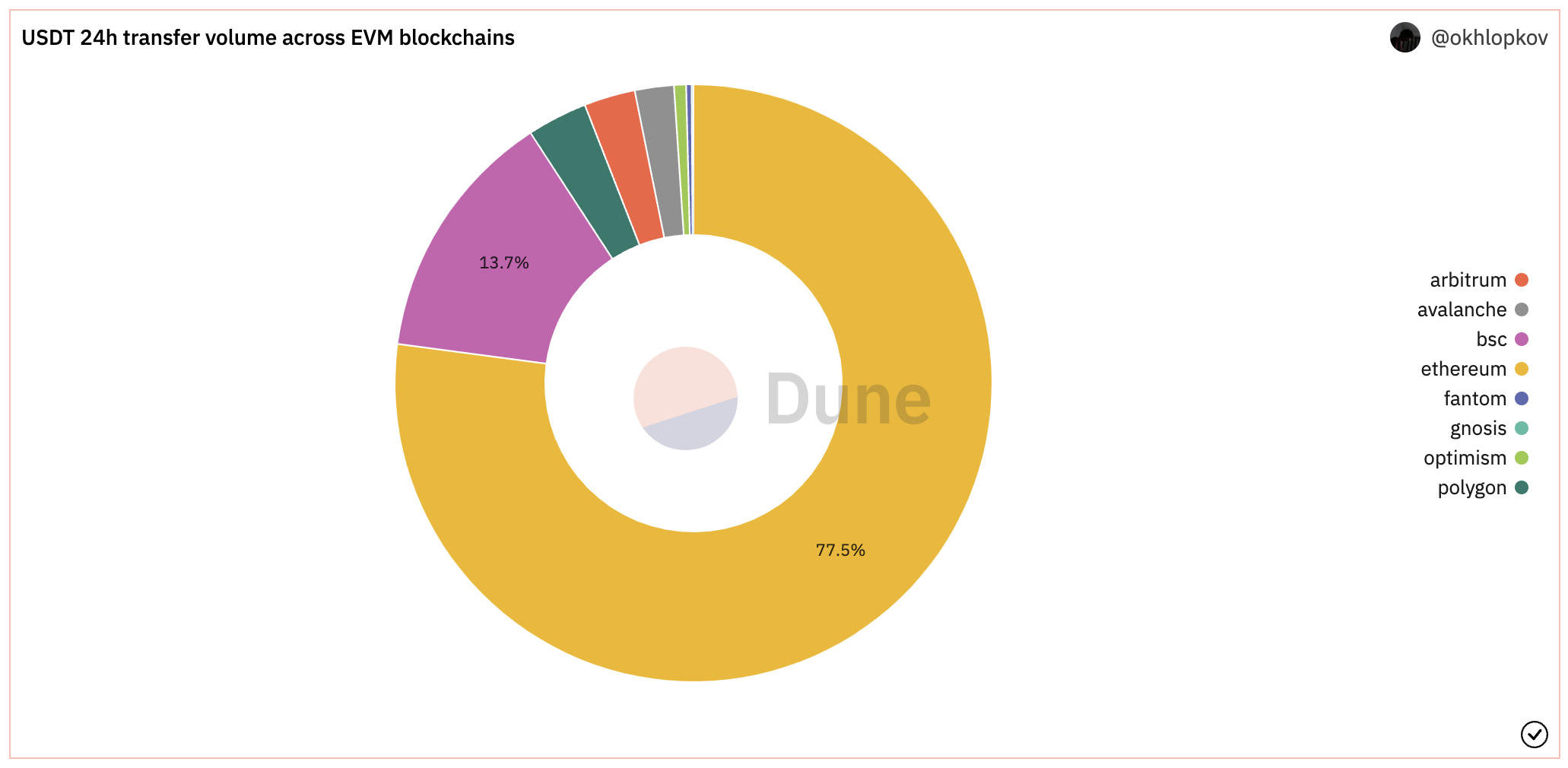On-chain USDT usage across popular blockchains
USDT is one of the most widely used stablecoins in the market, with a market share of nearly 50%. This article aims to examine the popularity of USDT across various modern blockchains, including EVM-like blockchains such as Ethereum, BNB Chain, Polygon, Arbitrum, Optimism, Fantom, Gnosis, and Avalanche, as well as others like Solana and Tron.
1. Tron
2. BNB Chain
3. Ethereum
⛔️ Why we can't use data from scanners / explorers
It is worth noting that the data available on EVM-like blockchains scanners is often taken from sources like CoinGecko or CoinMarketCap, which may include off-chain trading volume from centralized exchanges (CEXs) such as Binance or Coinbase, making it necessary to consider alternative approaches to assess the true popularity of USDT across different blockchains.
Be careful while using data from @etherscan or @solana explorer. 24h volume of a token doesn't relate to specific blockchain: it is just "total_volume" from @coingecko API for @Tether_to token.
— okhlopkov.eth 🍪 (@danokhlopkov) February 15, 2023
I wonder how this number was even calculated 🤔 pic.twitter.com/69xjRxRx2i
Instead, we can leverage DuneAnalytics to measure on-chain USDT transfer volume for the last 24h across several popular EVM-like blockchains:

As of today (2023-02-15), the 24-hour on-chain transfer volume for USDT on EVM-like chains stands at approximately $7 billion (~380k unique wallets), with the majority of transactions occurring on the Ethereum blockchain.
With BitQuery we can measure the same stats for Solana ($19M) and Tron ($12.1bn). By combining all the available data into a single graph, it becomes apparent that the trading volume of USDT on the Tron blockchain is greater than the combined trading volumes of USDT on all other examined blockchains.

It is worth noting that the reported figures can be potentially manipulated by spamming the network with large whale transactions. Additionally, the transaction count can also be falsified through controlling miners or having a significant budget for transaction fees.
🔬 Approach to measure real usage of a token
I believe in the potential for crypto mass adoption through the use of stablecoins as a substitute for traditional fiat currency in online and offline transactions. I envision a future where stablecoins will become widely accepted and integrated into everyday commerce.
Let's call a blockchain transaction "retail" if its USD amount is between $1 and $10k. In that case, we remove the impact of big whales and really small transactions.
It's possible that this metric has already been invented and has a different name. It's like how I came up with a move e2-e4 when I was a child.
Once we have filtered the transactions by volume, it doesn't make much sense to simply add up the volumes, as the chain with the most transfers worth thousands of dollars will have an unfair advantage. However, counting the number of retail users and retail transactions is meaningful, as it shows how many users are utilizing crypto-dollars similar to fiat currency.
💱 USDT MAU (retail) across different blockchains

In January 2023, when measuring total USD volume, unique sender addresses, total transaction count, and their 'retail' metrics, BNB chain emerged as the most popular EVM-like chain for USDT users, with 2.5 million active users. However, Tron blockchain dominated with 7.5 million active USDT users during the same period.
When applying the "retail" approach, I find that almost half of all USDT transactions on Tron were filtered out. In January 2023, USDT on Tron had
- 28.4 million transactions with a value of less than $1,
- 2.5 million transactions with a value of more than $10,000,
- and 33.8 million 'other' transactions ("retail").
There were 14.4 million transactions with a value of $0, indicating that almost half of all USDT transfers on Tron had a value of less than one dollar.
Using DuneAnalytics, we can observe a notable trend of USDT mass adoption on EVM blockchains. In 2022, the number of unique USDT "retail" senders rose by more than 40%.

📈 SimilarWeb as a proxy to blockchain popularity
When we compare the website traffic of EtherScan, BscScan, and TronScan - which are proxies for the popularity of their respective blockchains - we can see that despite having the highest USDT volume and active users, Tron's scanner is less popular than the scanners for Ethereum and BNB Chain.

🐋 USDT Whale transactions analysis
When we compare the percentage drop in total USDT volume after removing whale transactions on different blockchains, only 3% of Ethereum's USDT volume in January 2023 remains. This can be attributed to the high transaction fees on the Ethereum network, which incentivizes users to conduct larger transactions.
Surprisingly, only 7% of Avalanche's USDT volume is made up of "retail" transactions. Currently, the network fee for transferring ERC20 tokens on Avalanche is only $0.02, compared to $3.29 on Ethereum. It's puzzling that almost all USDT volume on Avalanche is dominated by whales, and it raises the question of why they chose this chain.
🏁 Conclusion
I was surprised to discover that the Tron blockchain has the highest USDT usage compared to other blockchains, while BNB Chain has the highest number of retail active users across all EVM-like blockchains. In contrast, almost all of the USDT volume on Avalanche comes from whales, and USDT on Solana ranks only as the sixth most used token.
Thank you for reading. Please share this article if you found it useful.
Links:
- My Twitter and Telegram
- Dune dashboard with USDT "retail" stats
- Google Spreadsheet with merged data
